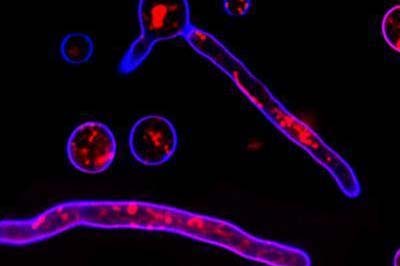Transforming mushrooms into fuel: promises greener cleaner energy
The government's team of academic researchers announced that a fungus like spider that adheres to military uniforms and tarpaulin sheets could hold a key to progress in the natural production. Biological data.
In an article published on May 5 on Nature Biotechnology, researchers at Los Alamos National Laboratory and Genetic Institute affiliated with the US Department of Energy reported that the genome of The fungus Tricoderma reesei has opened important traces of how the organism breaks down plant fibers into simple sugars. This finding could open up possibilities for industrial processes that can convert corn, switchgrass and even cellulose-based city waste into ethanol in a more efficient and beneficial way. more cost. Ethanol is made from waste products that feature more neutral carbon for gasoline.
Mushroom T. reesei created doubt during World War II when military leaders discovered that it spoiled clothing and tents quickly in the South Pacific. The name of the mushroom is named after Dr. Elwyn T. Reese, who co-operated with his colleagues to isolate the fungus, T. reesei, later recognized as a source of industrial enzymes and as a key model. for the conversion of cellulose and hemicellulose - plant fibers - into simple sugars.
Microorganisms use enzymes that it produces to break down plant fibers that humans cannot digest into the simplest sugars like monosaccharides. Then the mushroom will digest this sugar as food.

The photo shows a microscope image of the silk fibers of the fungus Tricoderma reesei.In the picture, proteins in fungal cells are marked in red while chitin - a component of cell walls - is marked in blue.(Photo: Mari Valkonen, VTT Finland)
The researchers decoded the gene sequence of T. reesei in an effort to discover why the dark green fungus is extremely good at digesting plant cells. Chain results are surprising in some way. Contrary to what one can predict the genetic content of a fungus that can puncture a fabric tent, T. reesei has fewer genes that contribute to the production of cellulose-eating enzymes than copies of it.
"We are very aware of the title of T. reesei as a bulk producer," said biologist Diego Martinez of Los Alamos (also at New Mexico University), who led the study. Enzymes disintegrate, however, we were surprised by the way some of the enzymes it produces, which shows us that its protein secretion system is particularly effective. ' The researchers believe that the T. reesei genome consists of 'clusters' of genes that secrete enzymes - this is a trick that explains the organism's effectiveness in breaking cellulose.
On the industrial scale, T. reesei can be used to secrete enzymes, which can be filtered in and added to a mixture of water cellulose powder and other materials to produce sugar. Then the sugar is fermented by alcohol yeast to produce ethanol.
Joel Cherry - director of second generation biofuel research activities for Novozymes (a collaborative research organization) - said 'The sequencing of the fungus genome Trichoderma reesei is a Important steps towards the use of renewable raw materials for the production of fuels and chemicals. The information in the genome of this fungus will help us better understand how these microorganisms decompose cellulose effectively, and how it produces the required enzymes in a real way. often. By using this information, we can improve both those characteristics and reduce the cost of converting cellulose biomass into fuel and chemicals. '
Other authors of the study are: Thomas Brettin, David Bruce, Chris Detter, Cheryl Kuske, Olga Chertkov, Melissa Jackson, Cliff Han, Monica Misra, Nina Thayer, Ravi Barbote, and Gary Xie of the national lab. Los Alamos (JGI-LANL); Jarrod Chapman, Igor Grigoriev, Isaac Ho, Susan Lucas, Nicolas Putnam, Paul Richardson, Daniel Rokhsar, Eddy Rubin, Asaf Salamov and Astrid Terry belong to the gene factory in Walnut Creek, CA (JGI-PGF); Scott Baker and Jon Magnuson of the Pacific Northwest National Laboratory.
Other collaborative research organizations include the US Department of Agriculture and Forestry Products, Oregon State University, University of New Mexico, Chile Catholic University, and Finland's Technical Research Center ( VTT Finland), and University of d'Aix-Marseille I & II.
- The new method transforms sunlight into fuel
- Fuel from mushrooms
- Sharp is coming out of the vacuum cleaner market to say
- Top 10 most rare mushrooms in Vietnam
- Giant mushrooms appear in mass in Hue
- History of the vacuum cleaner
- Fuel production aircraft from mushrooms
- Identify deadly poisonous mushrooms in Vietnam
- 5 types of mushrooms are not only beautiful as fairy but also delicious and incredible
- Eating mushrooms can prevent cancer but not eat meat or fish
- Photos of beautiful mushrooms in nature
- Mushroom saves the world environment
 Why do potatoes have eyes?
Why do potatoes have eyes? 'Tragedy' the world's largest carnivorous life: Death becomes ... public toilet
'Tragedy' the world's largest carnivorous life: Death becomes ... public toilet Tomatoes were once considered 'poisonous' for 200 years
Tomatoes were once considered 'poisonous' for 200 years Detecting microscopic parasites on human face
Detecting microscopic parasites on human face